
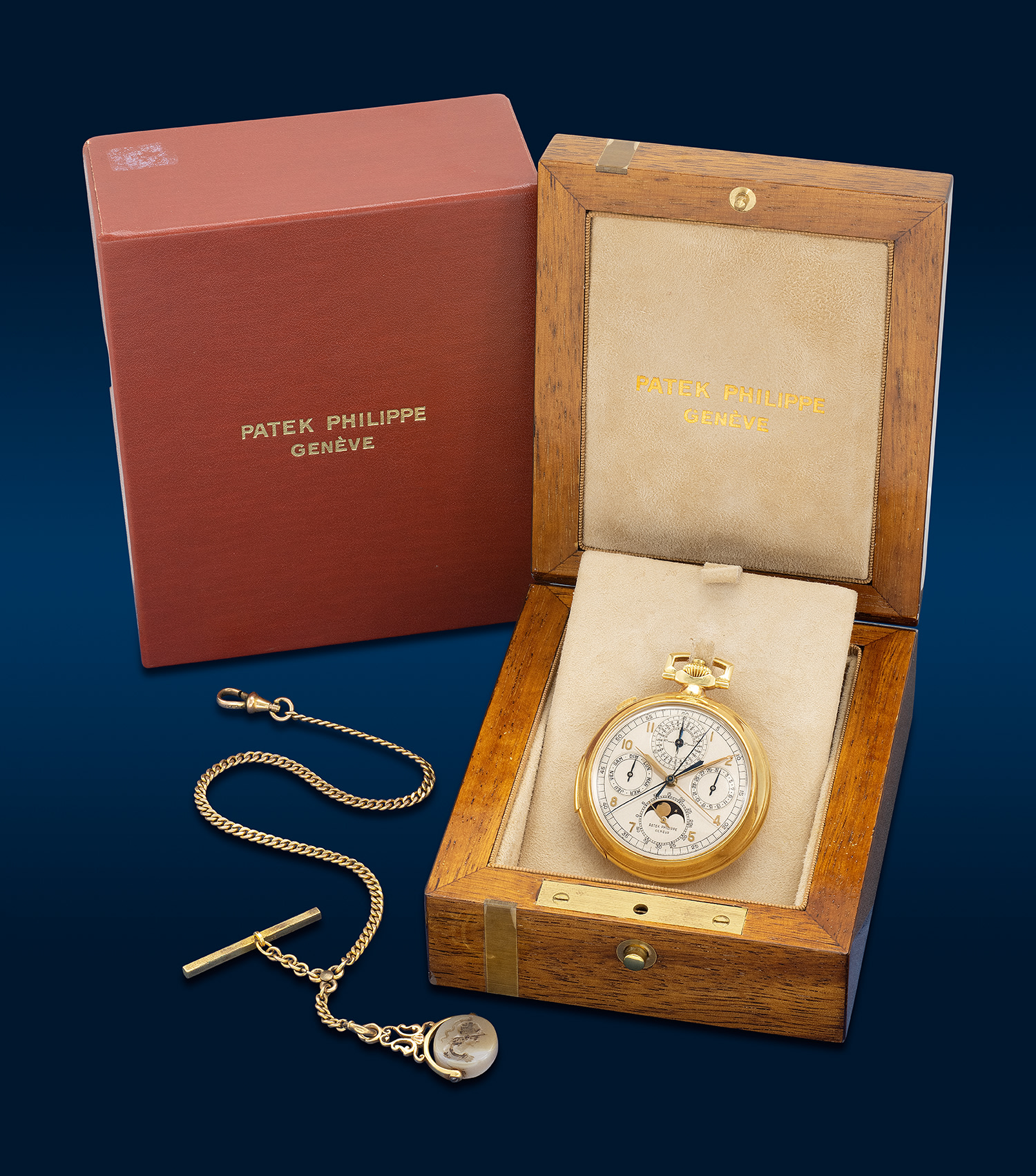
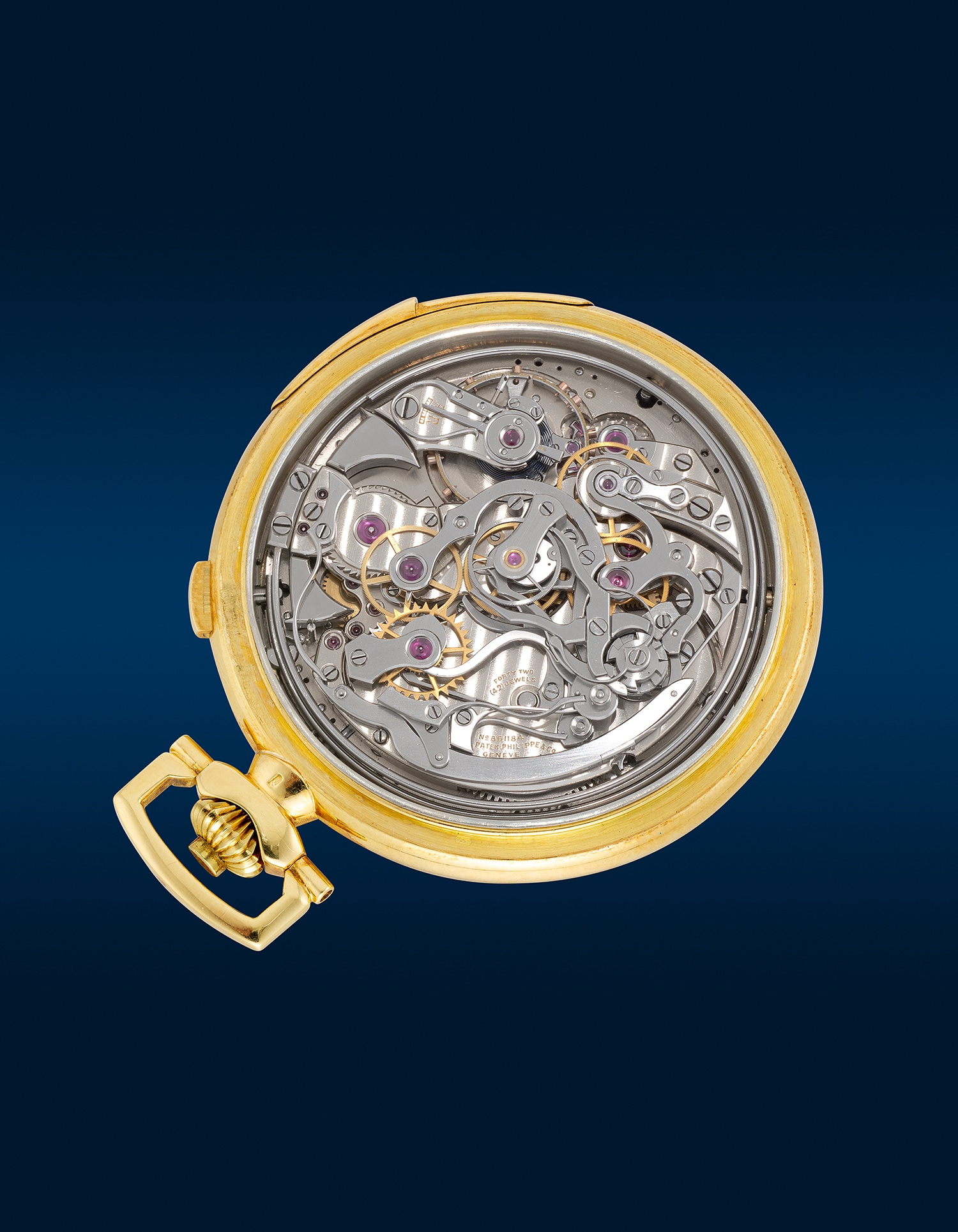
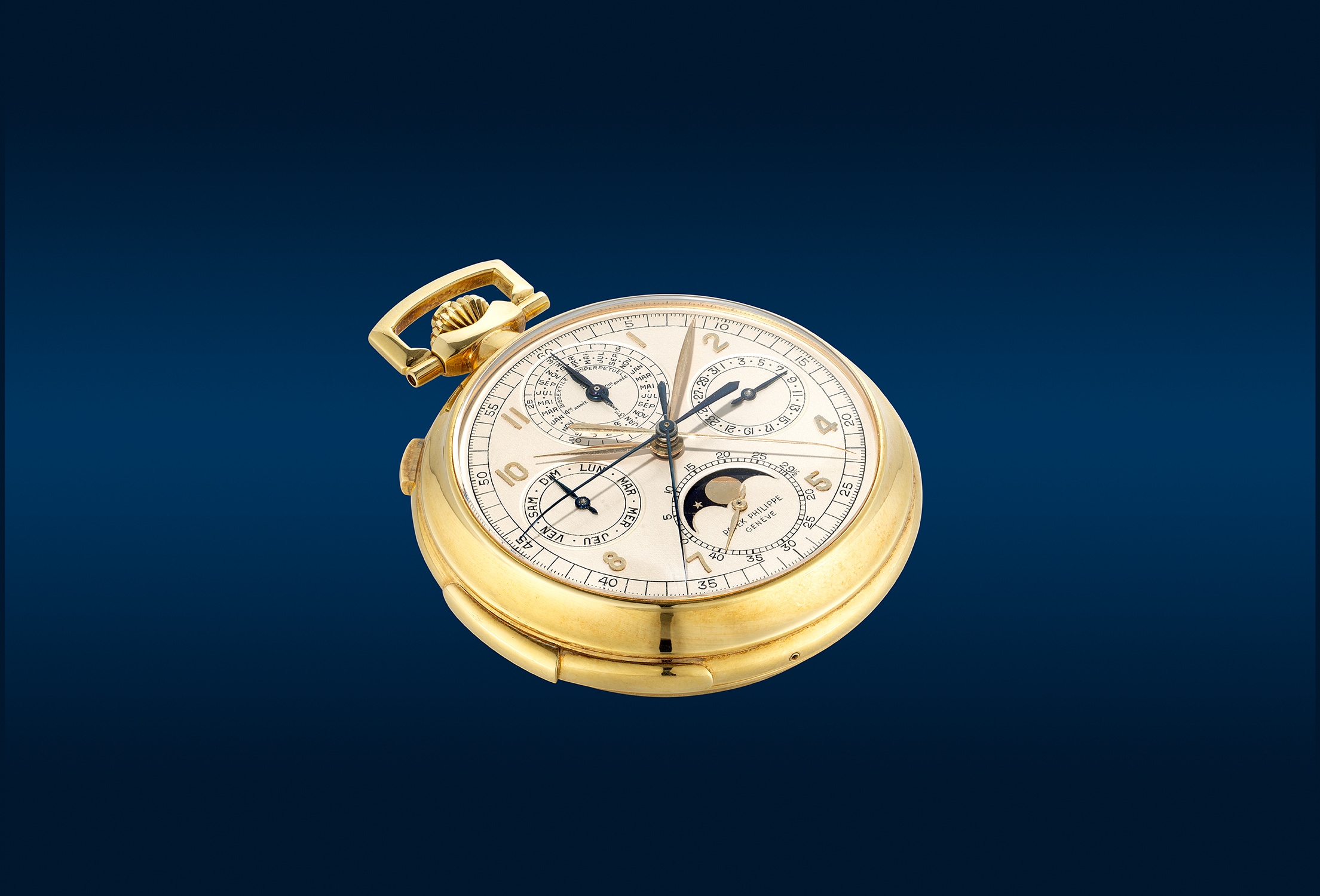
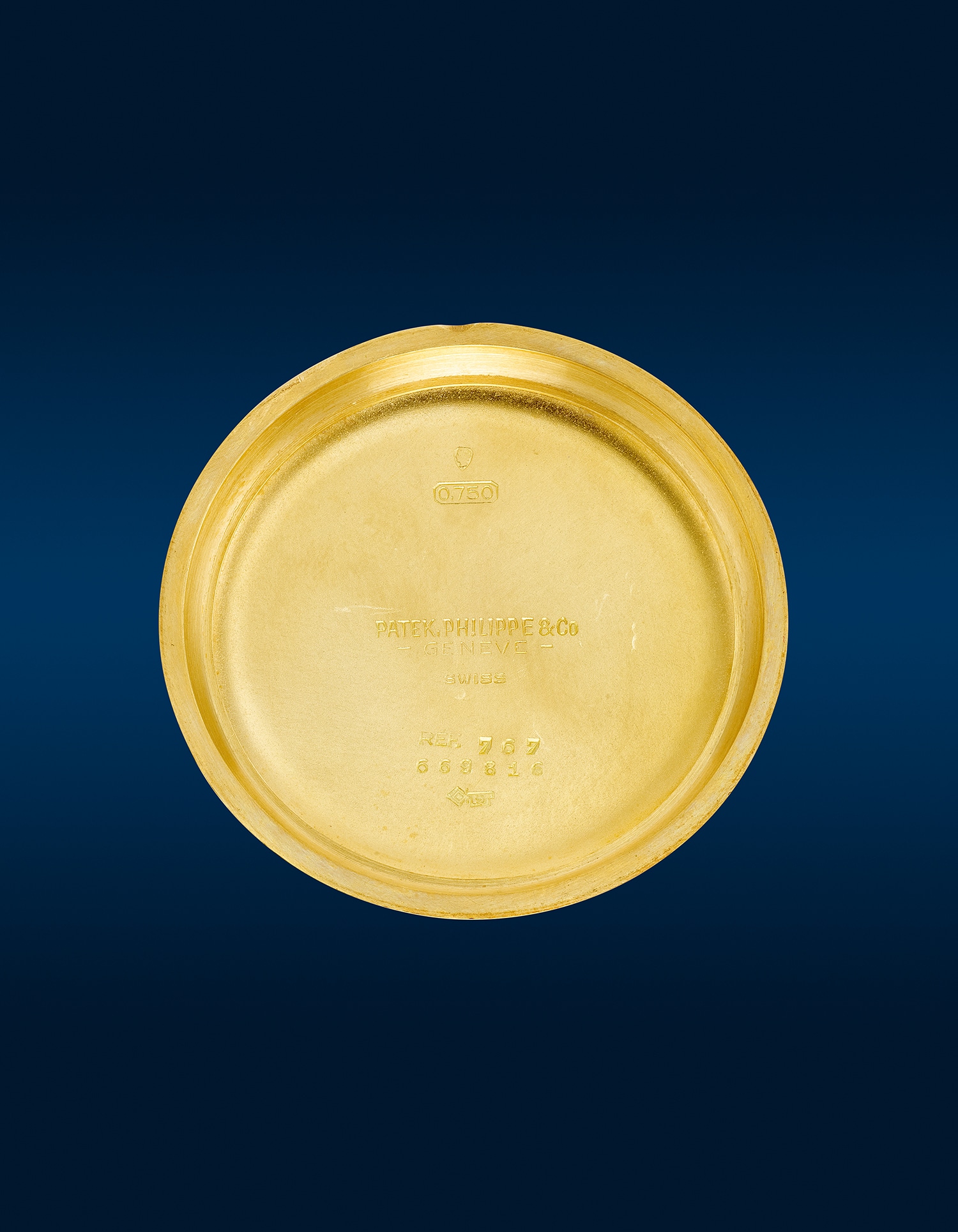

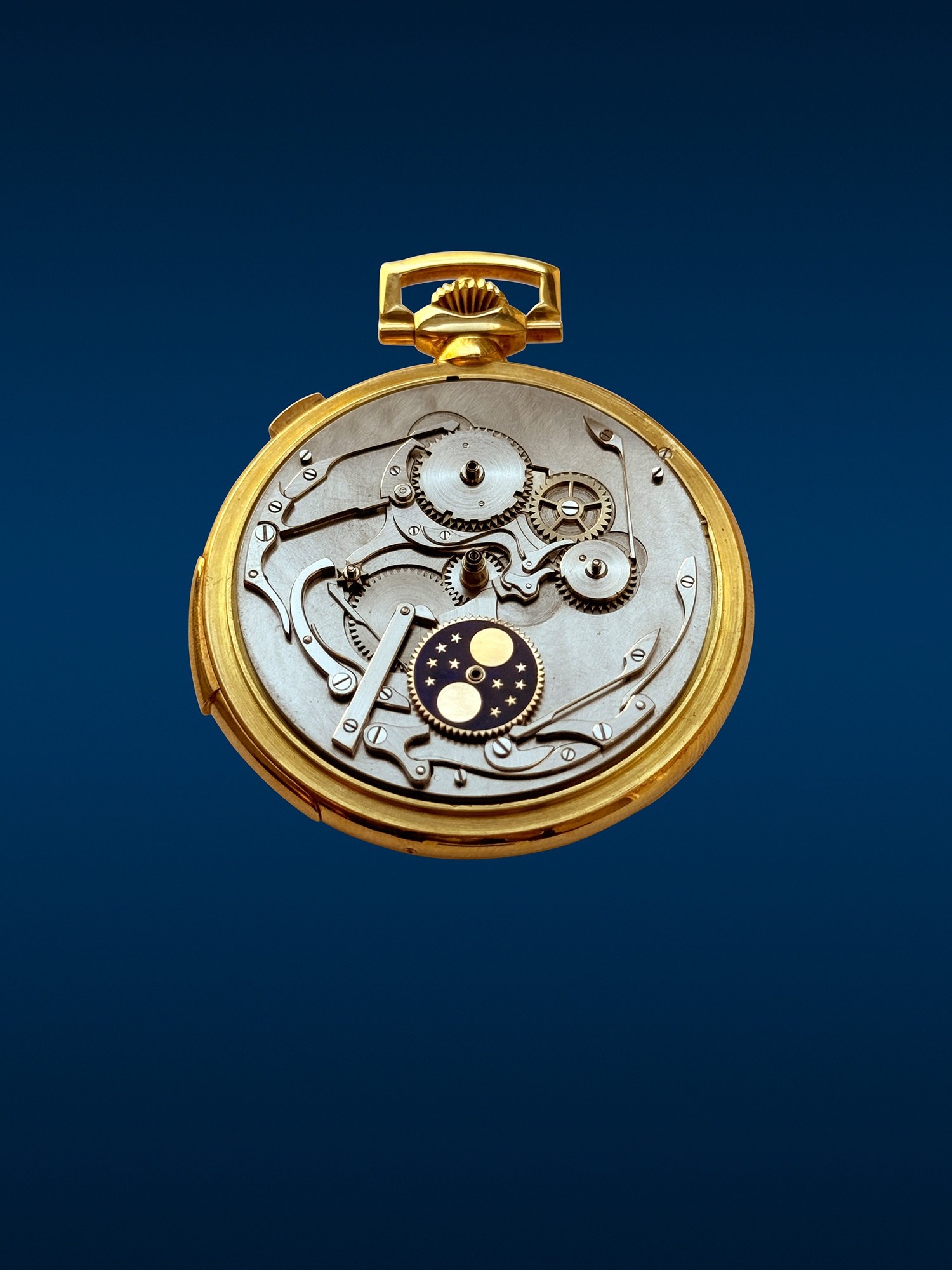
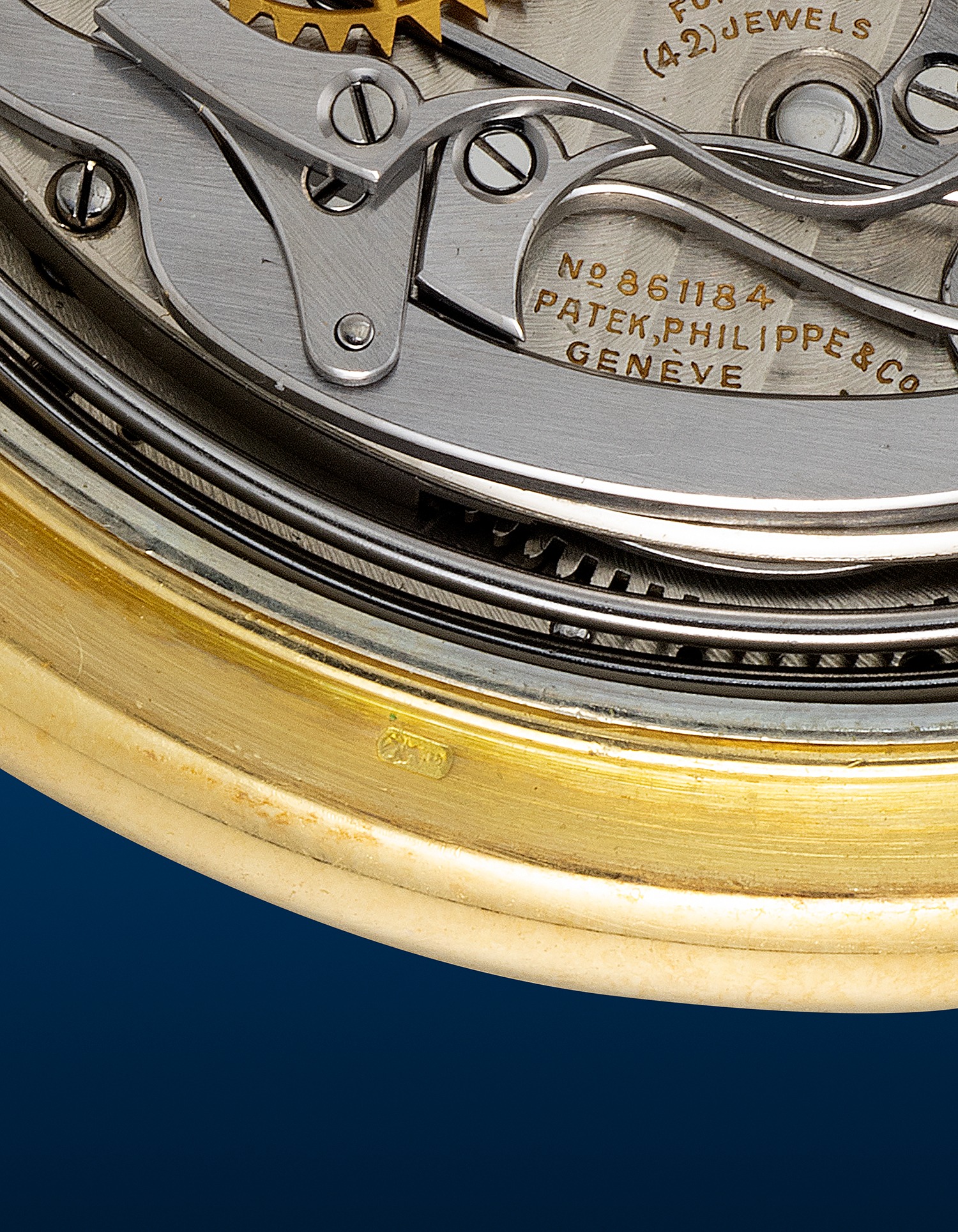
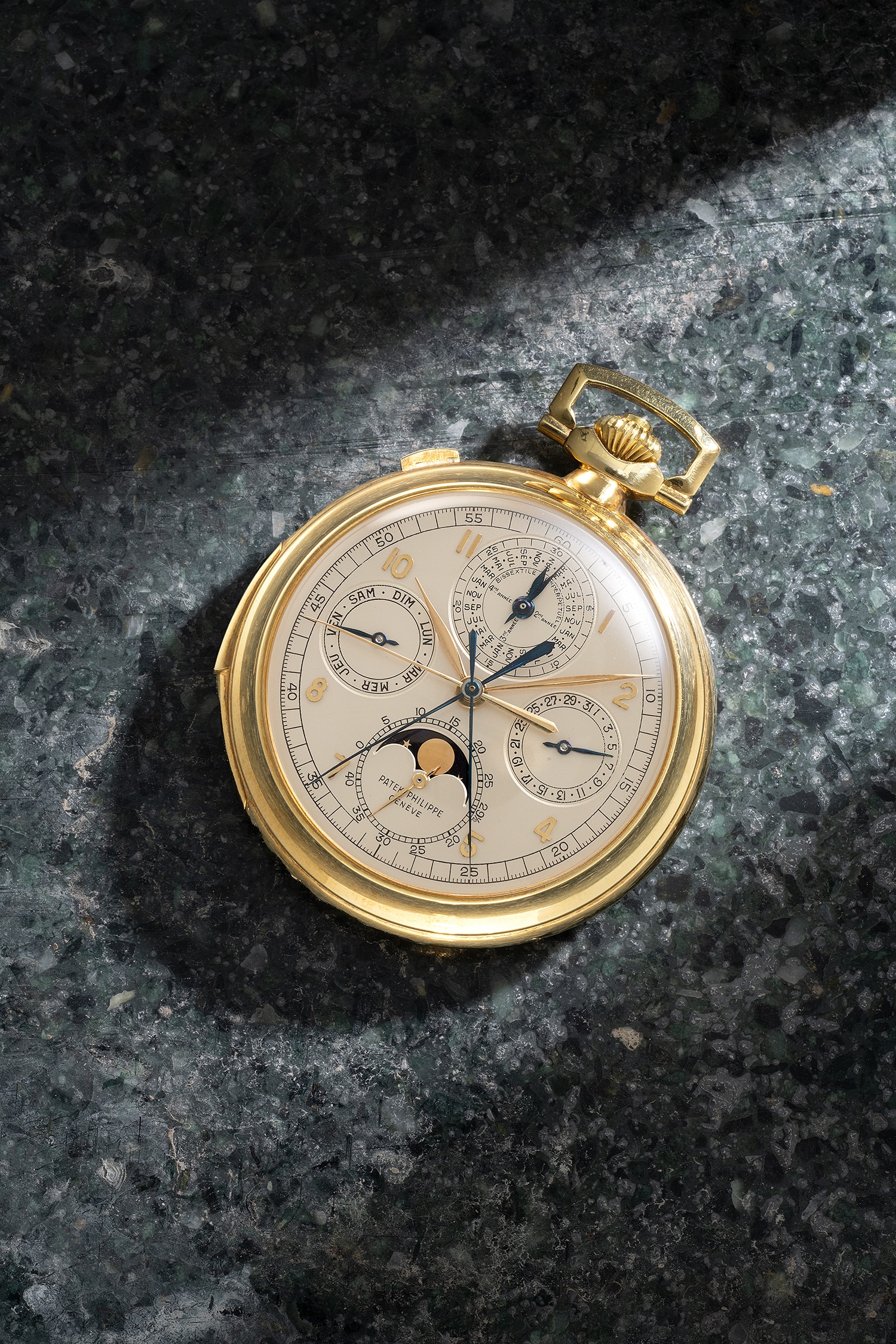









862
Patek Philippe
Ref. 767
A possibly unique and historically important yellow gold minute repeating perpetual calendar double-split chronograph open-faced keyless pocket watch with “modern” style case, leap year indicator, applied Arabic numerals, French calendar, moon phases and presentation box
Full-Cataloguing
A trip to the Patek Philippe Museum in Geneva, a temple to one of the world’s most important and prestigious horological collection will surely take your breath away with the splendor of the firm’s technical prowess and craftsmanship, especially the immeasurable collection of pocket watches. From embellished pieces with enamels and engravings, lavish ornamented works of art, to automatons, these creations of horological complications have always held great fascination and punctuate the history of Patek Philippe.
Any addition to the basic indications – hours, minutes, and seconds – is considered a complication. These intricate functions may require one or more additional hands to indicate other time zones or the astrological events that mark time divisions: day, date, month, leap year, and lunar cycle. They may indicate time by repeating mechanisms sounding the precise measurement of small intervals of time. They may also measure time with accuracy.
Patek Philippe’s first ever horological complication pocket watch with not one, not two, but three complications was made in the late 19th century. One of such is the Triple Complication and part of the Patek Philippe Museum collection is No. 47’721, the hunter case pink gold pocket watch was bestowed with a minute repeater, a perpetual calendar, and a chronograph powered by a 20’’’ Piguet Freres movement. It was also one of the first pocket watches with instantaneous calendar ever made. Exhibiting all the characteristics that made Patek Philippe one of the foremost horological firms of the 19th century, it was shown at the 1876 Centennial International Exhibition in Philadelphia.
Fast-forward to the first step away from the post-war period, Patek Philippe refreshed the line of Triple Complication into modern age with the launch of the reference 767 in 1950. A wonderful evolution from the maison’s traditional horological past, the “Moderne” reference was open-faced with clean and elegant lines, the bows are prominent and arched with integrated crown guards. 50mm in diameter, the three parts with a snapped caseback, majority of the reference 767 were crafted by master Geneva watchmaker Antoine Gerlach (Key number 4). Fitted with important movements found in inventory from the 20’s and refurbished, these pocket watches were cased after the 1950s all into yellow gold cases, each with their own unique nuance. The dials were also unique to each, such as the variation of Arabic and baton hour markers, some even feature a moon phase at 6 o’clock instead of 12.
To the best of our knowledge, only 7 examples of the ref. 767 have ever appeared publicly, first exemplifying its rarity, but most important of all, it puts the spotlight on its most outstanding feature of this present ref. 767. The only known example to feature a double-split chronograph mechanism, a total of 5 hands mounted on the central pinion: Hour, Minutes, Chronograph, and Double-split hands.
Ref. 767 known in the market
Movement Case Sold Chronograph function
127’687 313’380 1965 split seconds
157’321 Unknown Unknown split seconds
174’148 Unknown 1964 split seconds
197’676 687’004 1959 split seconds
197’731 687’005 1961 split seconds
198’106 687’006 1960 split seconds
861’184 669’816 1952 double-split seconds (Present example)
Boasting incredible resemblance to the legendary perpetual calendar chronograph ref. 1518 with attractive Arabic numerals that marks the hours indexes. According to our research, the present specimen is possibly the only example to feature a French calendar, perhaps a special request by a distinguished collector, and was sold on 8th July 1952, being one of the earliest known example. The pocket watch was also prominently illustrated in the important Patek Philippe Geneve book by Martin Huber & Alan Banbery. According to our research, we believe that this very example was part of the Seth G. Atwood’s private collection. He founded the Time Museum Rockford in the United States in 1971, which later became one of the leading horological museums in the world with nearly 1,500 pieces of important horological pieces. The hall of fame from the collection includes the Patek Philippe Henry Graves Supercomplication, the quarter-repeater by Thomas Tompion and the Breguet Sympathique Clocks. An exceptional and highly regarded collector who collected the best of the best, it is absolutely no surprise to anyone that this particular museum-worthy ref. 767 was previously part of his possession.
Stunningly preserved in all its glory, the 1518-esque engraved enamel dial is exquisite and impeccable with matching movement number engraved on the underside. Setting this example apart from the rest is the vividly stamped key number 9 on the inner caseback. We learn that the present ref. 767 is crafted by legendary case maker Emile Vichet widely known for his creation of the highly valued and sought-after 1518 and first series 2499. The acoustic of this minute repeater is warm and pleasing to the ear. 11 hour strikes, three quarter strikes and 14 minute strikes, a constant tempo as each chime rings through the ears of generations. The Stern family for decades delivers the purest of chimes toward its long history of watchmaking. All is defined by solely the sound that rings to your ear, and none does it better than Patek Philippe.
The Split Chronograph
Ever since the existence of humankind, the science of measuring time has been crucial within our society. The curiosity of precision aids us to a long evolution of advancement for tracking time. The chronograph, which measures the duration of an event played a critical role in horological history. 1822 began a time where French watchmaker Nicholas Rieussec invented and constructed the first chronograph. Indicated with an ink reservoir, elapsed time were marked by a drop of ink on the dial.
Twenty years later, Adolphe Nicole, Swiss watchmaker from the vallée de Joux was granted a patent for a chronograph mechanism that made it possible to have a seconds hand returned to its initial position. The “heart” of this mechanism is called “zero-reset heart cam” which is commonly used in most mechanical chronographs till this day. It further took another twenty long years for Nicole to present this device into a watch format. 1862 was the year that the first ever pocket watch that mastered the now well-known functions that constitute a chronograph: start, stop and reset.
Split-Chronograph: Comparative time measurement of one event up to 2 targets
The chronograph was an important cornerstone for Patek Philippe’s history. The company began researching the measurement of brief time intervals just a few years after its founding in 1839. Driven by horological aspiration, Patek Philippe continuously stressed the refinement of technologies and the ongoing development of complications, and on 13th November, 1902, the first double chronograph mechanism or “split-seconds” was patented by the firm with a Victorin Piguet 19 lignes ébauche. Measuring intermediate times simultaneously, this is made possible by two chronograph seconds hands superimposed on each other.
To illustrate the steps simply:
1. The chronograph is started, the two hands advance together
2. The chronograph hand (upper hand) is stopped, allowing an intermediate time to be read.
3. The seconds chronograph hand (lower hand) is stopped
4. Return to zero of both hands
Double-split Chronograph:
Comparative time measurement of one event up to 3 targets (the present example)
The double-split chronograph mechanism is a chronograph with three hands mounted on the central pinion. An additional module is added on top of the split-seconds construction to achieve this feat.
Gold hand – Split seconds hand
Short Blue hand – Independent chronograph hand
Long Blue hand – Sweeping seconds hand
Alternatively, the independent chronograph function indicated by short and long blue hands can be activated by a single pusher positioned at 12 o’clock with four functions (Start, Split, Stop and reset) similar to a monopusher. While the split seconds chronograph requires the pusher at 11 (Split and Catchup) and 12 o’clock (Start, stop and reset). However, the chronograph cannot be restarted after the second time had been recorded.
Pioneering precise measurement and compare single and additive times down to seconds and minutes in the early 20th century, it was only then, a century later, the addition of time measurement of a double-split function with 30 minute counter onto a wristwatch in 2004.
Possibly unique and kept in an astute private collection whom acquired this ref.767 for decades, this is a testament of Patek Philippe prowess by breaking records, devising, and constructing exceptional pieces that required years of interdisciplinary research into the fields of astronomy, mathematics and precision mechanics.
Patek Philippe
Swiss | 1839Since its founding in 1839, this famous Geneva-based firm has been surprising its clientele with superbly crafted timepieces fitted with watchmaking's most prestigious complications. Traditional and conservative designs are found across Patek Philippe's watches made throughout their history — the utmost in understated elegance.
Well-known for the Graves Supercomplication — a highly complicated pocket watch that was the world’s most complicated watch for 50 years — this family-owned brand has earned a reputation of excellence around the world. Patek's complicated vintage watches hold the highest number of world records for results achieved at auction compared with any other brand. For collectors, key models include the reference 1518, the world's first serially produced perpetual calendar chronograph, and its successor, the reference 2499. Other famous models include perpetual calendars such as the ref. 1526, ref. 3448 and 3450, chronographs such as the reference 130, 530 and 1463, as well as reference 1436 and 1563 split seconds chronographs. Patek is also well-known for their classically styled, time-only "Calatrava" dress watches, and the "Nautilus," an iconic luxury sports watch first introduced in 1976 as the reference 3700 that is still in production today.